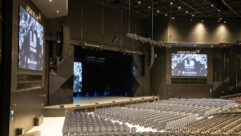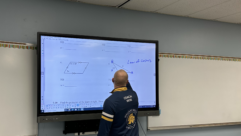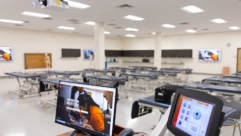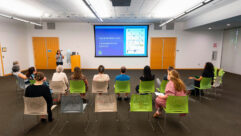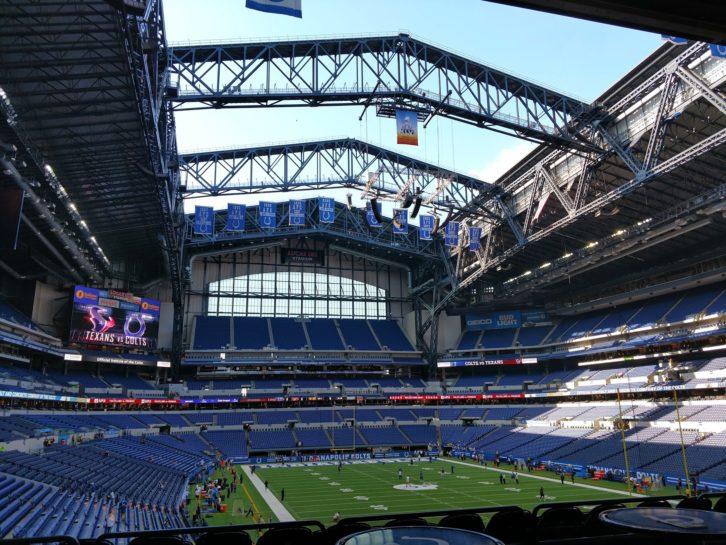
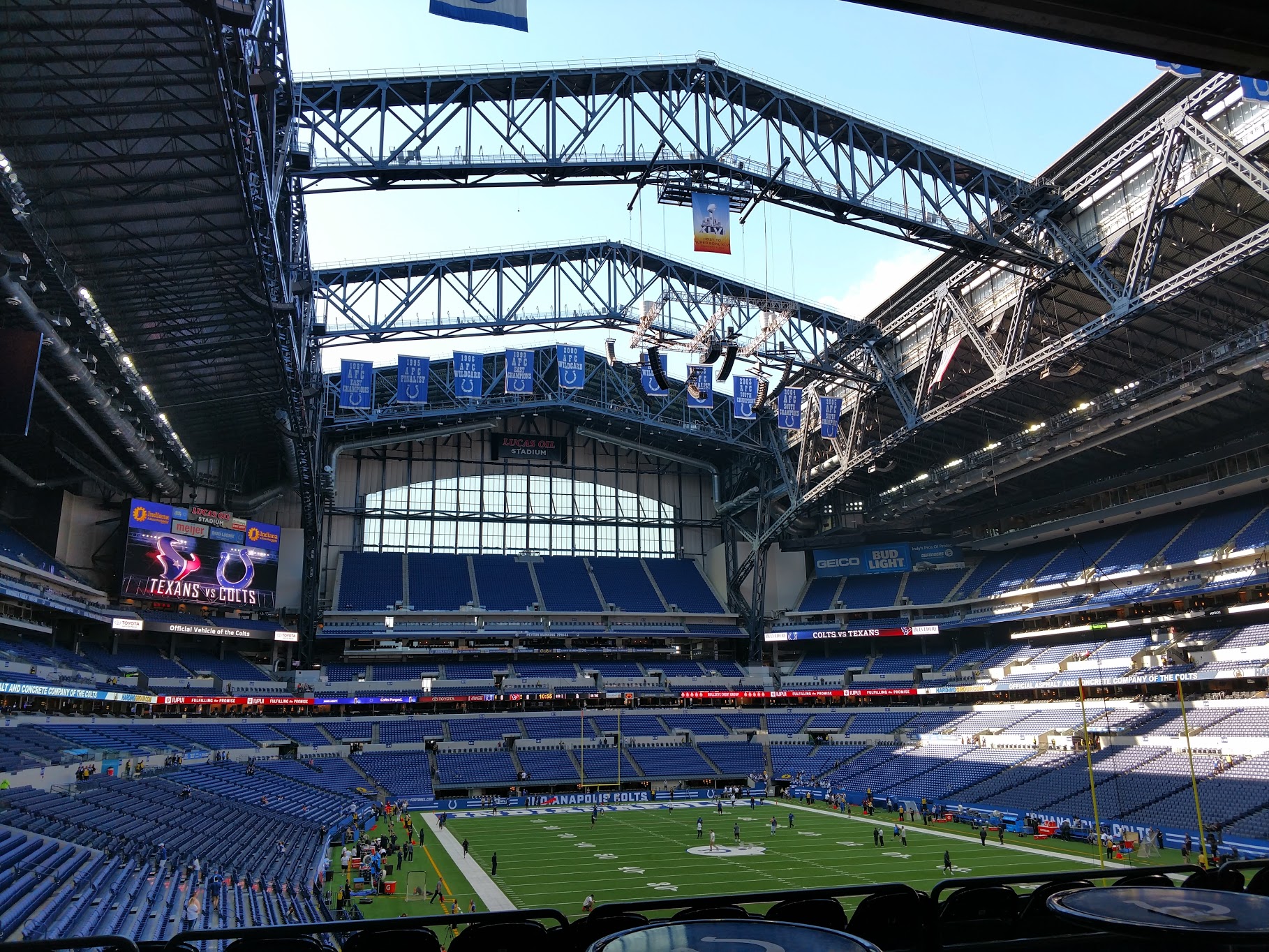
Though it opened ten years ago, Lucas Oil Stadium remains a state-of-the-art multi-purpose facility seating over 67,000 fans with a retractable roof. Home to the NFL’s Indianapolis Colts, its flexible design can also accommodate NCAA basketball, and concerts among other national and local events.
The seven-level stadium design has embraced AV and digital signage technology since opening its doors. And like many stadiums, it has extended the AV experience past the stands. The Lucas Oil Plaza, located on the north street level of the stadium is a public congregation area for events and concessions featuring a multitude of performance motor vehicle exhibits. Since the beginning signage has helped set the mood in this dynamic space. But it was time for a change.
The plaza’s original digital signage network included 13 single displays and a 16-screen, 4×4 video wall, blending Lucas Oil promotional content with entertainment. In operation for 10 years, the original AV/digital signage system was implemented in an archaic manner. Much of the operation was manual and de-centralized, using a rack-mounted touch panel to power certain systems on and off, switch video sources and manage other control elements. Meanwhile, the team had to go directly to DVD players and certain displays to turn them on. A cluster of noisy, power-hungry and heat-producing 4RU servers that fed digital content increasingly began to fail.
The 4×4 video wall also began to prove problematic. As years progressed, and displays died, it became increasingly more difficult to source identical replacements. The original NEC 52-inch displays also each featured a ¾-inch bezel, which equated to a 1-1/2-inch gap between displays. Increasingly, the wall noticeably resembled a checkerboard, even as bezels have all but disappeared from modern displays.
With centralized control, system reliability, and visitor experience all lacking, the decision was made to substantially update the network in two phases: First, a new digital signage network deployment; and second, an engaging video wall that would breathe new life into the overall AV operation. In both cases, the new network, comprised of seven motor sports-themed displays and a more dynamic 16-screen video wall would be more automated, visible, energy-efficient, scalable, and pleasing to the eye.
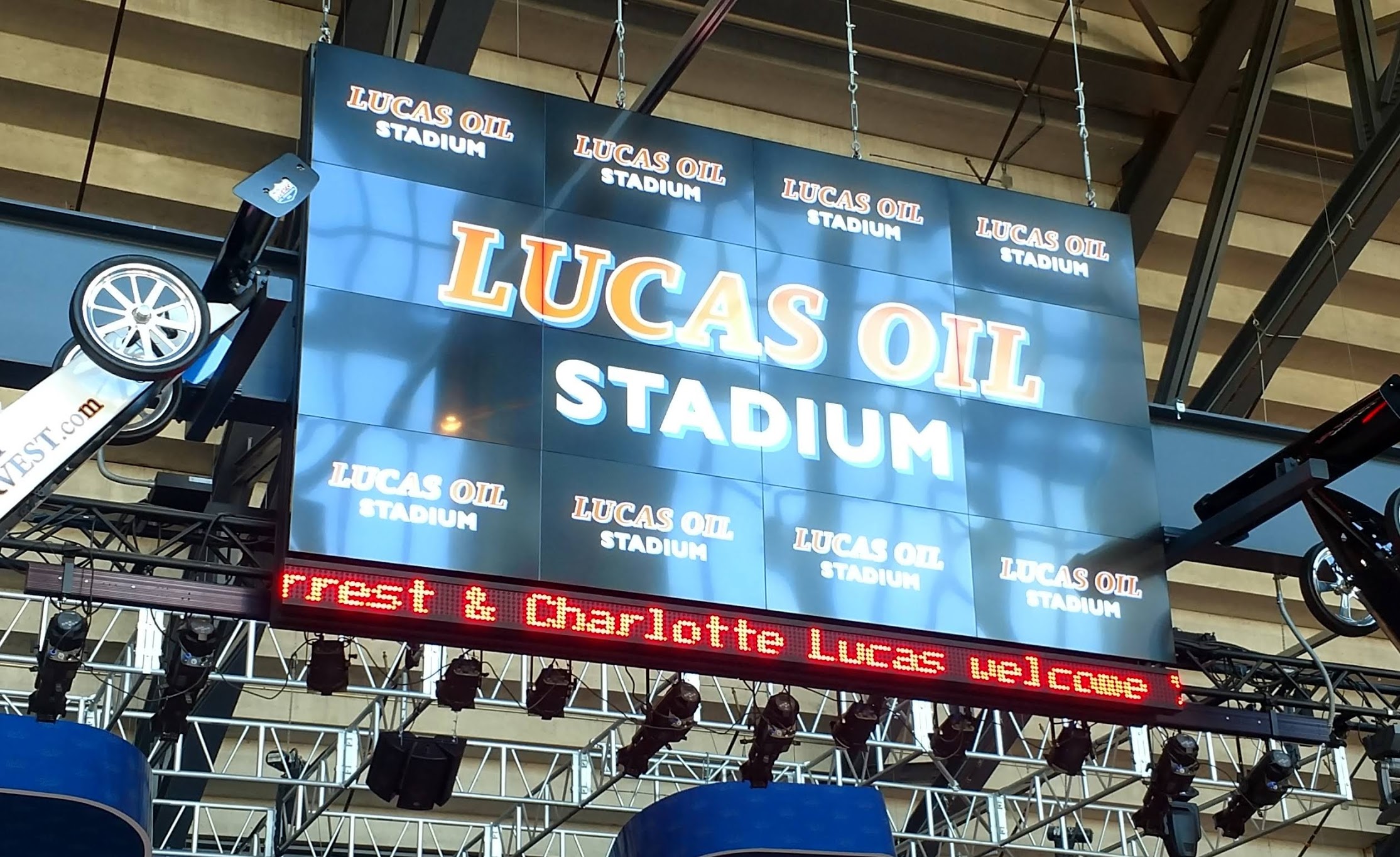
While the Lucas Oil Plaza signage network has always had a broad footprint, the content has been fairly simple. The previous Dell servers fed PowerPoint slides and content from DVD players and laptops to the various endpoints. However, the expense of maintaining the original system, coupled with its fading reliability, clearly pointed to a new strategy.
The Plaza’s existing wired infrastructure was repurposed and provided plenty of bandwidth to distribute and control content over IP. This steered toward an AV over IP architecture to support the second-generation digital signage network, leading to Atlona for networked distribution and control, and BrightSign for digital signage content management and playout.
As IT technicians, the team was at home managing systems over IP networks. These systems are far more dynamic and flexible than working with legacy circuit-based systems, where operation is fairly limited to its original premise at the time of installation. Moving to IP made sense as a common infrastructure that could scale easily, and support new applications and technologies as the AV vision evolves.
The migration to IP also overcame many potential signal and distance limitations inherent in legacy systems. As large as Lucas Oil Plaza is, a system was needed that would achieve greater signal distribution distances, and easily add PoE network repeaters when and where necessary.
Atlona’s OmniStream AV over IP platform proved the ideal choice for switching and distribution over the network. There was an immediate benefit from the integration perspective: OmniStream worked with the existing wired infrastructure since there was twisted pair wiring from the central rack to the various displays. Furthermore, OmniStream could operate with multicast transmission applied to each switch. This would avoid sending AV traffic to network devices that did not require it, saving bandwidth and eliminating device potential lockups due to related network traffic.
In addition to the single displays, the OmniStream rack feeds the Plaza’s 4×4 video wall. The video wall’s location prevented any feasible option to install (16) separate twisted pair runs to the decoders behind each display. Instead the choice was a single high-bandwidth infrastructure—a 10Gb copper CAT6a backbone from the core switch to all other switches, which further preserves network bandwidth. Having a detailed static IP address allocation for all devices also proved essential to ensure system stability and reliability, avoiding any potential shifting IP addresses or IP conflicts.
The OmniStream source distribution is comprised of three OMNI-112 dual-channel IP encoders and an OMNI-111 single-channel IP encoder. This is all located in a central equipment rack with the source equipment and two Cisco SG350X-24MPP core network switches. In the plaza, a total of 23 OMNI121 single-channel IP decoders feed the screens, with one decoder assigned to each display (16 supporting the video wall and seven supporting the exhibit displays). An additional two network switches were added behind the video wall to support the OmniStream decoders and each display’s LAN communication.
PoE capability allowed for centrally managed power to the OmniStream encoders/ decoders, and all digital signage content is reliably disseminated with visually lossless video quality, and no noticeable signal latency.
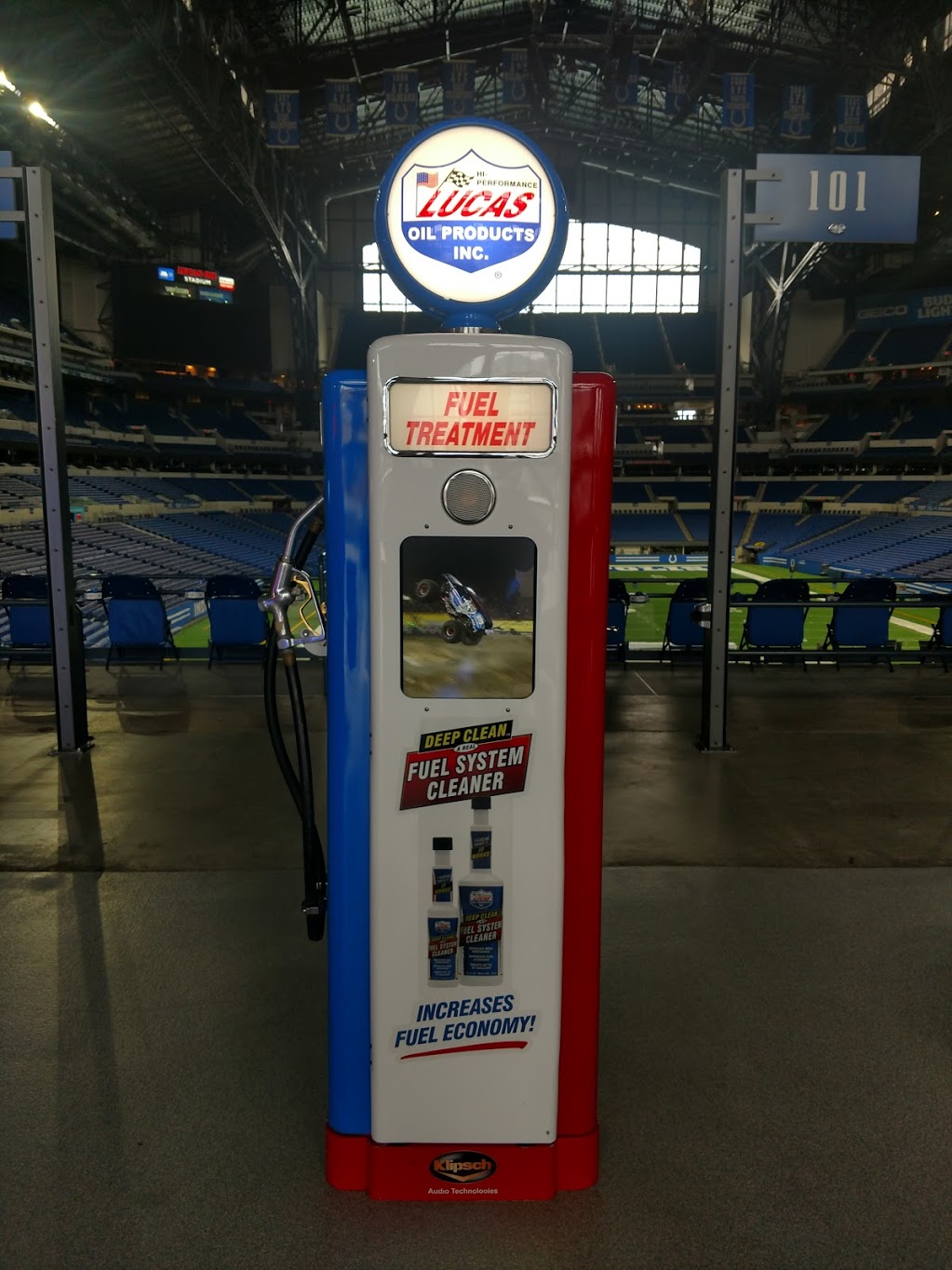
Integration of the exhibit displays and video wall first required a significant teardown phase. Removal of the video wall was itself an enormous task: Each display and mount had a combined weight of roughly 150 pounds, equaling roughly a literal ton of total weight removed. The fact that the video wall was suspended 20-to-30 feet in the air only exasperated the situation.
The outer panels of the existing video wall enclosure were stripped down to its frame, and a total of eight 16-foot sections of horizontal channel strut were added for the new display mounts to attach to. New CAT6A UTP cabling was also pulled to the video wall to provide plenty of bandwidth for multiple simultaneous video sources to be displayed (if desired).
Once the exhibits were prepared, the installation process began for the new screens. The new video wall is comprised of 16 LG 55VX1D landscape screens, with Chief ConnexSys mounts supporting the displays. These are precision mounts offering six points of adjustment across height, tilt, depth and lateral movement.
The digital signage displays are fashioned as creative kiosks, with positioning in key traffic areas – some of which were repositioned for more visibility to fans. Two 86-inch LG landscape displays were added to the restrooms; dual LG 42-inch landscape displays were added to two Oil Bottle exhibits; dual Elo 17-inch portrait displays were added to two antique Gas Pump exhibits, and a single LG 49-inch landscape display was added to a performance motor teardown exhibit.
On the source end of the digital signage system, the latest technology was utilized to improve overall playout. BrightSign digital signage has greatly simplified how we manage our digital signage content. Previously the original A/V integrator had to be involved to facilitate all content changes. BrightSign’s BrightAuthor software now makes it simple to accommodate changes in house with one person, intuitively and on short notice. Importantly, the system “wakes up” when plaza power is turned on for the day, with content playout resuming where it left off. This is both a convenience benefit as well as an efficiency improvement that preserves stadium energy.
The BrightSign XT1144 players bring similar operational benefits. The players are solid-state, which means we no longer have to deal with computers and an operating system to support playout. The standard player configuration loads and loops the content from an SD card, with no concern about computer security, failing hard drives or maintaining the OS. The digital signage players are modestly priced enough to allow quick and simple swap out at the connection point in the event of a failure.
The standard content playing on each exhibit display includes:
- Video Wall: Lucas Oil Racing series and products
- Restrooms: MATV (Lucas Oil’s TV network) motorsport racing content
- Oil Bottles: Lucas Oil Off-Road racing content
- Gas Pumps: Lucas Oil Monster Jam and motocross content
- Engine Display: Lucas Oil NHRA drag-racing content
Both OmniStream and BrightSign will support 4K content, but the current content is HD – a big step up from the analog-only video support of the previous architecture. Live sources can also be injected into the network for the first time; when delivered from laptops or plugin sources, an Atlona HD-SC-500 three-input scaler up-converts the content. When required, the Plaza’s Klipsch Pro Audio system is utilized to distribute digital signage audio content via the system’s analog audio matrix.
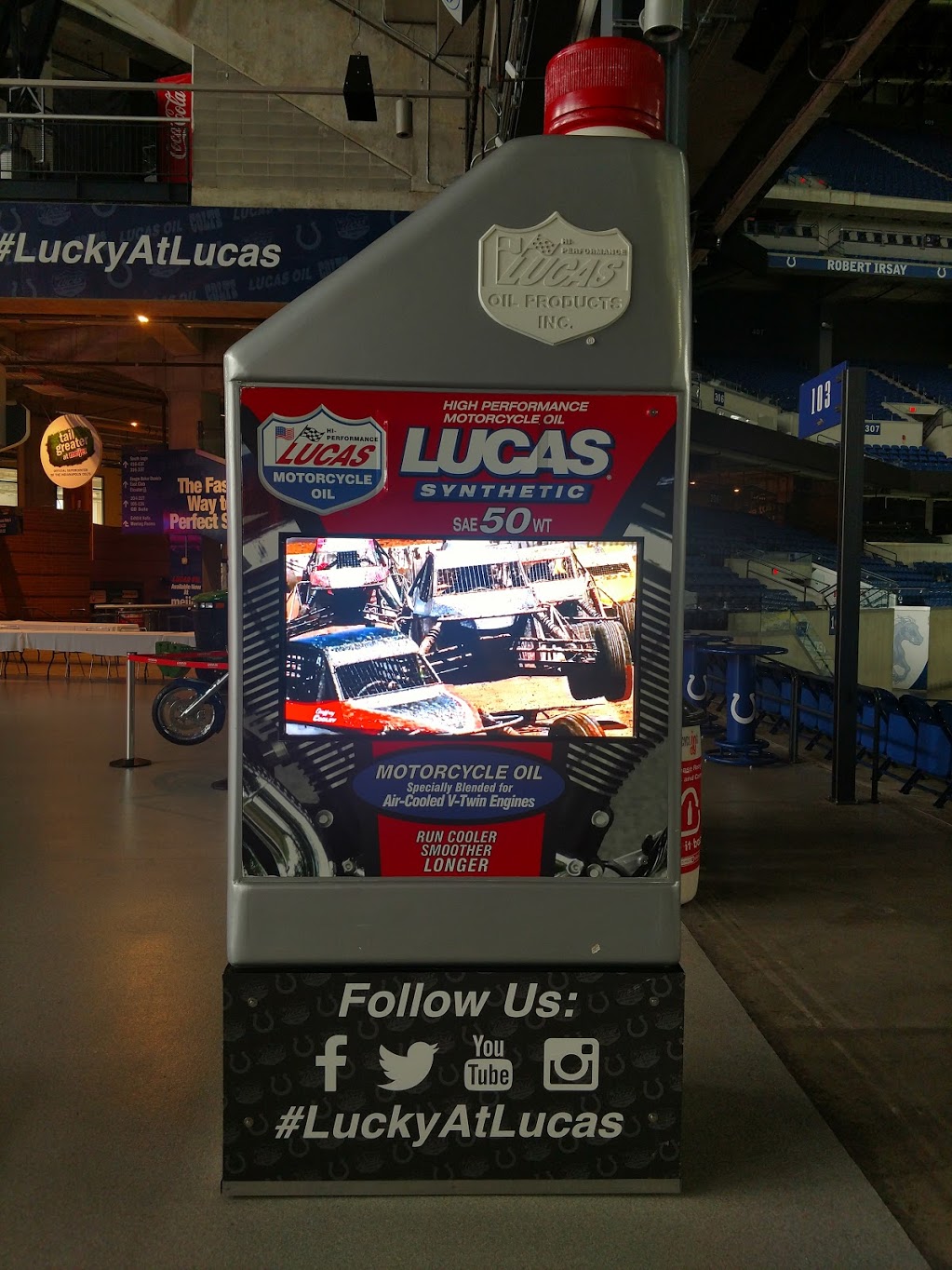
The move to centralized control using the Atlona Velocity control platform over the network has perhaps been the greatest operational efficiency boost. In addition to eliminating the very manual and siloed approach to control on site, it has liberated the staff through remote control operation. Staff can remotely connect the system, troubleshoot issues, and update the system’s configuration among other benefits. The system can also be controlled through smartphones and tablets utilizing the intuitive tap-and-drag UI that Atlona’s Velocity provides.
Ease of configuration was an immediate benefit. Velocity’s web-based configuration software includes a large number of predefined devices in its database – in fact, the Lucas team only had to custom-configure one driver for our audio matrix. The system’s event macros automated many of the processes as the configuration progressed. This was achieved via a simple pull-down menu, and selecting the event and action to be performed; Velocity has a very extensive drive database.
Perhaps the most beneficial aspect was the simple assignment of inputs and outputs for the OmniStream distribution network. Specifically, there were no manual command steps required to map encoder inputs to decoder outputs, which accelerated the video routing configuration process. The programming for this element was automated behind the scenes, so it understands how to map outputs based on drag-and-drop events.
Beyond leaving behind the manual control processes of the first-generation system, the remote management features of the new system deliver the greatest operational value. Velocity’s user interface is clean and uncluttered, which allows one to view the system and easily talk technicians through an operating process or a troubleshooting issue as needed. Remote service is as simple as accessing the menu and configuration on a smartphone.
The system is still modest enough where the Velocity Cloud service is not required. Control requests are processed through the Velocity VGW-250 Gateway, connected with a rack-mount 15-inch Elo Touchscreen PC. The customized Elo touchscreen operates in kiosk mode and displays the Velocity user interface. The UI is web-based and responsive, allowing almost any element to toggle on and off. The benefit is customization to suit any environment or user.
There are innumerable benefits of moving to an AV over IP environment, many of which have been stated above. While there are no immediate plans to further expand the system, the IT network and AV system infrastructure are well-prepared to accommodate future changes, including options to connect video cameras and social media feeds to the signage network, particularly for presentation on the video wall. As referenced above, the second-generation network is architected to accept and inject live sources, which is a big change from before.
At any rate, moving to AV over IP means no longer being boxed in by a fixed switcher and input/output limitations. Adding more displays is as simple as making the routing and control connections.
James Crain is Facilities Manager and Cory Poore is IT and Network Technician, Lucas Oil Products, Inc.


